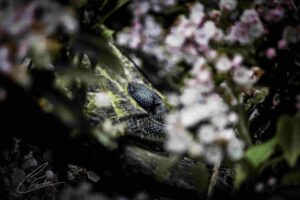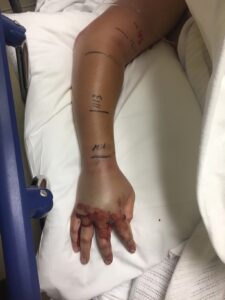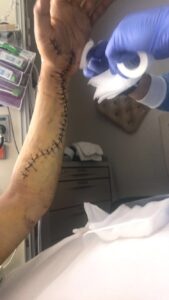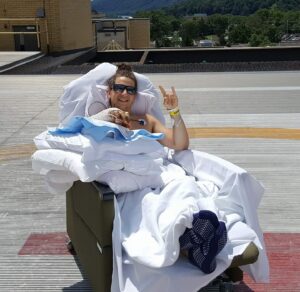By Cooper Ferko
Introduction: Surveyors encounter dangerous situations in the field, and this includes wildlife. We’ve all had our snake encounters, venomous and non. There was a time when I was cavalier about it, flicking a snake away with a range pole. But that all changed around a campfire, at my cousin’s family camp near Punxsutawney, Pennsylvania, when his youngest son recounted his harrowing snakebite ordeal. Outdoors enthusiasts, his family encounters rattlesnakes regularly and exercise appropriate caution. Yet these amazing but sometimes deadly creatures can be unpredictable. Here is his first-hand account as a cautionary tale for surveyors. – Gavin Schrock, PLS
The Encounter
Cloudy skies, misty thick air that seems to stick to your skin–not an ideal day to go looking for timber rattlesnakes; we did anyway. We found what we were looking for: a 50-inch black phase rattlesnake. As still as the skies before a storm, he sat on a moss-covered log with the bloom of mountain laurel juxtaposing his freshly shed skin. We all managed to walk by without catching a glimpse, and this would have been the end of the story until we heard, “Woah, hold up, look at this guy,” from the back of the pack.

A Timber Rattlesnake (Crotalus horridus), common in the Northeastern U.S., found by the author and his party – photo by Cooper Ferko
We admired the rattlesnake and take several photos. Using snake tongs, we bring him off his perch and into the pipeline grass where we can more safely handle the snake. We notice the snake has a dozen porcupine quills approximately two-thirds down his body, and joke about how harmoniously that interaction must have gone. As one of the guys begins to lower the snake into the bucket with a screw-on lid we use for safe transport of the snake from the location it is found to the roundup held in nearby Cross Fork, he strikes. In a fraction of a second, the creature we were just admiring, and photographing sank his fangs in my right hand.
Venom
Timber rattlesnake venom is considered a hemotoxin, this type of venom is known to destroy tissue in order to aid in the process of digestion of the snake’s prey. When a snake ingests its prey, there is a lack of enzymes to break down the meal, which is why the venom comes in handy, starting the digestion process from the inside out. A wild timber rattlesnake will mainly subsist on mice, squirrels, chipmunks, and birds typical among low vegetation such as huckleberry, blueberry and mountain laurel.
Due to the dangerous nature of their venom and their protected status, handling a snake is not just discouraged, it’s illegal without the possession of a venomous snake permit from the Pennsylvania Fish and Boat Commission. We had the proper permit, but little good it did me that day.

Almost immediately, the area around the bite, then his hand and whole arm began to rapidly and painfully swell – Photo credit – Cooper Ferko
I began rattlesnake hunting with a group of guys who had been participating in the Cross Fork Rattlesnake Roundup for more than a decade. I couldn’t pass up a weekend at camp where the backyard was a trout stream, and the days were spent hiking and hunting for a rattlesnake in hopes of winning the roundup. The hunt officially starts on Friday and the deadline to submit a snake for measurement is Sunday at noon. The three winners get announced for the heaviest snake, the longest total length, and the snake with the most rattles.
The Trek Back
(Once bitten and graced by ignorance), I remained calm with little knowledge of the severity of the situation that had just begun. I start the 1.25-mile trek back to the truck. The swelling started almost instantaneously at the location of the bite. In the remote Hammersley Wild Area, cell service is nonexistent, meaning help coming to us was off the table; so we walked. The ground was soft and swampy, sucking my foot through the mossy surface ankle deep with each step.
The venom was beginning to show its presence with a strong metallic taste and the inability to move my mouth to the point that a swig of water would make its way right back out of my mouth and onto my chest. My speech was slurred far worse than that of the patrons leaving the local watering hole at closing time. As we arrived at the truck, drowsiness and nausea took hold. I climbed into the backseat of my dad’s truck, my dad in the passenger seat and Cross Fork local Mike Stone behind the wheel, as he could have driven the backroads blindfolded. Mike had spent the last 30 years of his life in the state forestry industry, a man I always had many wildlife and forestry questions for and who always had the answers. I asked him questions, seeking comfort in my unknowing of what is to come.
After the half hour ride and a back-and-forth battle between fighting consciousness and profusely vomiting, we arrived at Bucktail Medical Center in Renova. A man rolled a wheelchair toward the back door, and I notified him and the guys I was with that I was unable to move my body enough to get out of the truck on my own. Whether it was the venom that had sucked the energy from me as it was trying to shut down my body or a paralysis effect, I have yet to figure out. As soon as I got wheeled through that automatic door another spell of vomiting struck me. I apologized and got a look of apology accepted in return. Four vials of antivenom are quickly administered.
Initial Treatment

A fasciotomy was soon performed, to prevent the skin from splitting, and to relieve some of the excruciating pain – Photo credit – Cooper Ferko
Antivenom is made by injecting a small dose of rattlesnake venom into an animal – typically a sheep, horse, or goat. The animal is injected numerous times over a few weeks. After a few months, the animal’s body has created a significant number of antibodies. A copious amount of blood is donated by the animal, and the antibodies are then removed – creating the life-saving serum. The antivenom does not reverse the effects of a snake’s venom, but smothers the venom and slow the damage. With enough antibodies, the harm of the venom is stopped.
The nausea and struggle to stay conscious seemed to fade as the antivenom ran through me, but the pain then took hold like a falcon’s talons onto a field mouse. Desperate for relief from the pain, I am refused medication as the doctor explains that my heart rate was so slow that pain medication could cause to stop entirely.
I’m quickly taken back out of Bucktail, not in a recovered state, but headed for a life flight, as I need more antivenom and Bucktail had given me its entire supply. The ambulance is rerouted on three different occasions by virtue of a severe thunderstorm moving in, preventing the helicopter from landing safely. I finally boarded the chopper at Williamsport airport for a flight to Geisinger Hospital in Danville, Pennsylvania. On the flight they are able to better stabilize me and give me a hefty dose of pain medications, followed by an explanation of how pain medication, no matter the strength, will not take away the pain I’m feeling – which is being caused by compartment syndrome and essentially had my hand and arm blown up to the point that it felt like it should explode. We arrive at Geisinger, where I spent the next 10 days.
The Long Road to Recovery
I waited in the pre-op room to undergo a fasciotomy, to relieve the pain and swelling, which is up to my shoulder. My hand is so blown up my fingers were fully spread and still touching, unable to perform the slightest bend. Imagine a balloon, one breathe away from bursting, but that balloon being my right extremity. Small little cuts on my hand were beginning to split apart.
On my way to the operating room, I looked forward to the anesthesia knocking me out, giving me a break from the pain. when I woke up after the procedure, somewhat disoriented, I noticed the pain has completely vanished. My family is there with big smiles, and for a second I wonder “am I alive right now?”
I was alive, and the surgery relieved the pressure in my arm, which was the culprit of the pain. My family was just so damn happy to see me, they couldn’t help but smile.
Ten days later, I am discharged directly from the ICU, where I had received constant care from the selfless nurses, who put smiles on my face; doctors, who knelt down and said prayers beside me when the slopes seemed steepest, and family and friends who were the greatest of company when it was needed most.

On the road to recovery. The author spent 10 days in the Intensive Care Unit.
Reflection
Through hypotension, hypertension, acute renal failure, along with rhabdomyolysis (muscle tissue breakdown resulting in the release of a kidney damaging protein), platelet counts less than 3,000, a swollen sack (four times walking around size), allergic reactions, 18 doses of antivenom, three surgeries and many laughs and a few tears, I’m left with an experience that reminds me of the fragility of life, expanding my focus on living each day with gravity and never taking an opportunity for granted.
In the moment it never hit that this could have gone south; retrospectively the weight of the situation seems heavier. And when there is no choice but to play the game with the hand you’ve been dealt, you’ll play it with grace, and if you don’t, you’ll have to pay up.
Be careful out there!
This story has also appeared in Backcountry Journal.

